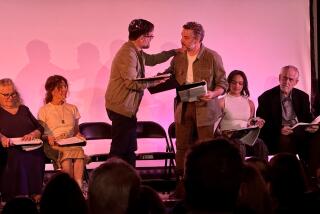Thinking on top of the box
Theater technology at its most complex and sophisticated placed at the service of a radically simplified movement metaphor: That’s “monumental,” the stark, abstract dance-drama about urban angst, performed by Canada’s Holy Body Tattoo on the UCLA Live series Friday in Royce Hall.
For half of the piece’s 75 minutes, choreographers Noam Gagnon and Dana Gingras kept their nine-dancer company marooned on box-like platforms, bombarded from every direction by the extraordinary lighting effects designed by Marc Parent and an assaultive, multilayered sound score credited to Gingras and three others.
Initially we saw a kind of tableau or frieze, but soon Sarah Doucet began slowly writhing, with the others eventually coming to life with their own expressions of anguish. Compulsively scratching at their hair, rubbing their hands together, stroking their arms, the dancers occasionally paused to scream in anguish or anger, looking exposed and helpless on their boxes as the light and sound effects kept changing.
Adding to the sense of the dancers being overwhelmed by fearful stimuli, a series of motion-picture environments and text projections punctuated their ordeal. Many of the texts were deliberately cryptic, and ultimately Jenny Holzer’s program note about individual responses to danger expressed the evening’s premise more astutely than any of her projected statements.
Whether falling into violent, spasmodic outbursts or sharing a defensive stance (in unison though unaware of one another), the cast functioned like lab animals in some cruel experiment about sensory overload and prolonged tension. Day Helesic crumbled immediately while David Flewelling fell, jumped or stumbled off his box but soon returned, clearly preferring familiar terrors to those unknown.
At this point, some idealists in the audience might well have assumed that isolation was the big problem and that if relationships had been possible, every holy body would have become a peaceful, loving vegetarian driving a low-emission hybrid vehicle en route to connubial bliss.
No way. Intently and without compromise, Gagnon and Gingras focused on something inherently self-destructive in human nature. They did include a sequence showing Andrea Gunnlaugson embracing and calming the out-of-control Helesic, but as soon as everyone left the boxes and the group action started, all the victims became nasty perpetrators.
Indeed, frantic brutality reigned during the last half of the piece, with the few glints of tenderness and humor merely setting up patterns of exploitation -- plus the forceful reiteration of the motifs we’d been watching since the piece began.
And here’s where “monumental” lost its distinction. On the boxes, Gagnon and Gingras inventively heightened ideas about confinement that had been circulating in the modern dance world ever since Anna Sokolow’s “Rooms” half a century ago, keeping the movement minimalist but investigating every possible variation in rhythm, dynamics, lighting and sound.
Off the boxes, however, their motifs proved tepid and, for all its antic energy, their choreography paled besides such definitive depictions of inhumanity as Paul Taylor’s “Last Look” and Angelin Preljocaj’s “The Rite of Spring.” The cast’s stamina sustained the performance, but only Farley Johansson twitched and flailed with enough convulsive power to make the movement materials momentarily thrilling.
The ending darkened further. After a buildup of word and image eruptions on screen and plenty of sonic overkill, a sudden blackout signaled apocalypse. Dancers with flashlights searched the void, and a voice informed us that “the flags are all dead at the top of their poles.” The survivors knelt at the footlights, as if warming themselves in front of a fire, and then exited, one by one, alone. But not before we saw sad vestiges of all the clawing-rubbing-stroking motifs that had conveyed their desperation early on. Whatever catastrophe they endured clearly hadn’t changed them, so “monumental” ended in a mood of hopeless resignation -- the lab animals freed from their cages, perhaps, but headed for another inevitable cataclysm.
Besides the dancers mentioned, the company included Ric Brown, Blair Neufeld, Sonja Perreten and Sarah Williams. Music was supplied by Roger Tellier-Craig, Les Tambours du Bronx and godspeed you! black emperor. William Morrison contributed the film segments.
More to Read
The biggest entertainment stories
Get our big stories about Hollywood, film, television, music, arts, culture and more right in your inbox as soon as they publish.
You may occasionally receive promotional content from the Los Angeles Times.










